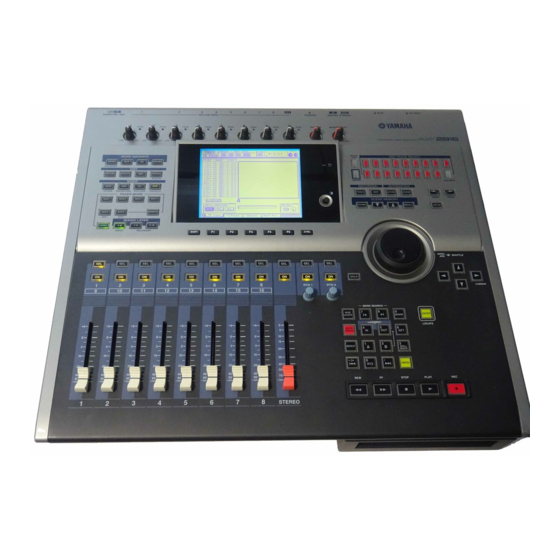Yamaha AW2816 Tutorial - Pagina 4
Sfoglia online o scarica il pdf Tutorial per Strumento musicale Yamaha AW2816. Yamaha AW2816 31. Professional audio workstation, recording101
Anche per Yamaha AW2816: Manuale operativo (2 pagine), Manuale di aggiornamento (2 pagine), Manuale (32 pagine)

Recording on the AW2816
Amazingly for its size, the AW2816 conceals potential
that rivals the mixing consoles found in large record-
ing studios.
Although you can of course record a live performance
in a single pass, you can also use multi-track record-
ing to take full advantage of the AW2816's 16 x 8 =
128 tracks.
This tutorial will guide you through the actual record-
ing process, so that you can learn how to utilize the
full power of the AW2816.
Creating a new song
In the WORK NAVIGATE section, press the [SONG]
key. When the Song List screen appears, move the
cursor downward, and press [ENTER] at the NEW
SONG button. You will be asked "Save current song?,"
so answer either YES or NO. Then specify the sam-
pling rate (Fs) and number of recording bits (Recbit)
that the newly created song will use, and press
[ENTER]. Next you will be asked whether you want to
import mixer data (for details refer to the AW2816's
"Owner's Manual," Reference section), but in this
case you need not select anything.
Now you can input a name for the song that will be
created. Press [ENTER] at OK, and the comment input
screen will appear. Unless you want to assign a com-
ment, simply select OK. A new song has now been
created on the AW2816's hard disk.
Recording the rhythm section
When recording a new song, it is usual to start by
recording the rhythm section first, in order to set
down the tempo and groove (rhythmic feel) of the
song. After you have created the structure and rhythm
of the entire song, you can add vocals, guitar, and
other backing parts to complete the song.
At this stage, you just need the drums, bass, and per-
cussion parts. In particular, recording the bass at an
early point in the process will clarify the chord pro-
gression of the song, and will make it easier for you to
perform overdubbing later. Parts that contribute to the
rhythmic feel of the song such as backing keyboard
and guitar chording should also be recorded early.
In the pages that follow, we will give several examples
of how the rhythm can be recorded. Refer to the
explanation for the method that you will actually use.
Using two mics to record the
rhythm
Since the AW2816 provides two channels of XLR mic
input, you can put up two mics in a recording booth
and record in stereo. In this section we are going to
assume that you will record using two mics.
Connect the mics to the AW2816
Obtain two mics with the same characteristics (as far
as possible, two mics of the same manufacturer and
model), and connect the mic cables to the AW2816's
INPUT 1 and 2 XLR jacks. If you are using condenser
mics, turn on the PHANTOM +48V switch located on
the back panel. (If you are using dynamic mics, leave
this switch turned off. Otherwise, the mic may be
damaged.)
Now let's check that the sound from the mic is actu-
ally being input to the AW2816. First turn the gain
controls of the input to make adjustments. Recording
at as high a level as possible will take the best advan-
tage of the AW2816's potential, and give you the best
sound. However if the level is too high, the sound
may be distorted or a hissing noise may be recorded
along with the sound, so use caution. Adjust the gain
so that the PEAK indicator located at the upper right of
the gain control just barely flickers when you play
most loudly. If the PEAK indicator does not light even
when the gain control is turned all the way to the
right, check the connections once again, and if they
are OK, use the following procedure to check whether
the meters move.
Tutorial
3
